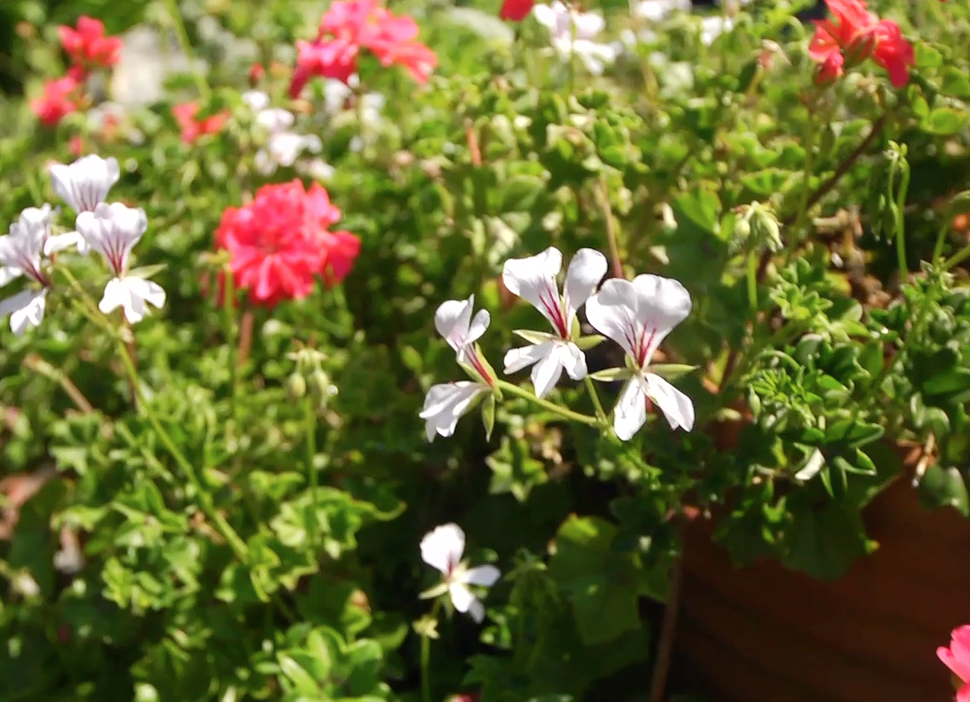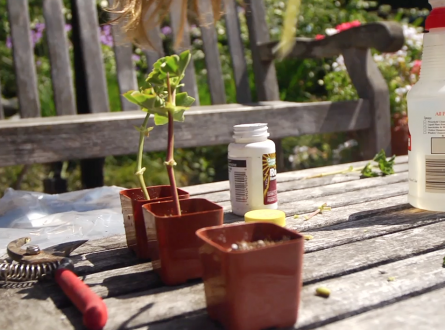Propagating geraniums by taking cuttings is an easy way to multiply your plants and an ideal plant to clone.
Once you master the basics of propagating geraniums, no geranium plant will be safe from your garden pruner!
Ivy-leaved Geraniums were the first plants I learned how to propagate and I remember asking, “Why isn’t everyone doing this?”
You probably have a geranium in your garden right now that you can practice your cloning chops with.
If not, take a walk around the block and when you spot one you like, ask your neighbor for permission and take a cutting!
Why Propagate Your Own Plants?
The garden centers are full of affordable, eye catching plants these days.
Why multiply your own plants?
If you have a favorite or nostalgic plant that isn’t produced anymore and isn’t patented- cuttings are an ideal way to make more plants!
Best of all, it’s free.
Watch my video: “How to Propagate Geraniums (Stem Cuttings) Ivy Geraniums, Pelargoniums” on Youtube!
For those of you who like to watch my “how-to” videos, here’s one that’s short, informative, and entertaining.
I promise you’ll remember every step!
My husband did, and he’s not a gardener.
Not even close!
Materials For Geranium Propagation
- Sanitized hand pruner or scissors
- Small pots
- Sterile, lightweight potting soil
- Spray bottle for watering your cuttings
- Rooting hormone to stimulate root growth
- A healthy “mother plant” to take cuttings
Steps For Propagating Geraniums
1. Select a healthy geranium plant that will act as the “mother plants” from which all new plants will come from.
It’s all about the genes, so go ahead and discriminate!
Look for sturdy stems, green leaves, robust flowers and avoid plants that are diseased or infested with pests.
It’s best to identify your mother plant while it’s in flower so that you know what to expect from it- your plant will be a clone!
2. Take cuttings.
You will need to cut a stem that is between four to six inches long.
Take your cuttings early in the day, morning is ideal because of mild temperatures.
Cutting a plant during the hottest part of the day can magnify stress in a plant.
Remember, you are extracting a living entity from it’s life source and creating a new home for it!
Make it comfortable transition!
Short geranium stem
Cut your geranium stem at a 45-degree angle, directly below a node.

Nodes are bumps along the stem that are growth points for leaves, stems, or new roots when propagating plants.
Illustration of node on a plant stem
A node is a swelling along the stem where leaves emerge from.
The new roots of your geranium plant will grow beneath the node, so make sure to make a clean cut.
3. Remove the lower leaves from the stem and any flowers or buds along the top.
Lower leaves are vulnerable to rotting since they may come in contact with the soil.
Flowers and buds should be removed in order for your new plant to concentrate on growing roots and not to maintain flowers!
Three or four leaves should be retained along the top of the stem for photosynthesis and to support the growing cycle.

Rooting hormone improves rooting success for geraniums. You can try cinnamon as a natural rooting hormone too!
Rooting hormone for stem cuttings
4. Dip the bottom of your stem into rooting hormone.
Some gardeners argue that rooting hormone is not necessary for success in cloning geraniums, but I find that it gives new plants a “fighting chance.”
Dip the bottom 1/4 inch of the stem into rooting hormone and dust off the excess powder.
Too much rooting hormone can damage a young plant.
Less is more.
Geranium cuttings in pots
5. Insert your cuttings into a small pot that is filled with pre-moistened lightweight, sterile potting soil.
Bury the part of the stem that has rooting hormone on it.
It’s vital that the soil be moist for the cuttings to prevent wilting.
Misting bottle for cuttings
6. Mist your cuttings!!
During the first few weeks of the growing period, mist your plants daily so that they don’t dry out.
Avoid using a watering can- the force of the water stream can dislodge plants.
Protect your cuttings from evaporation!
It’s the cause of death for many new plants.
*Zip loc bag as a mini greenhouse!
7. Cover your cutting pots with a plastic bag.
Oh, the joy of repurposing materials for the garden!
*I caution you if you overwater the soil and cover with plastic, you may encourage root rot, so proceed with caution!
Zip loc bags are a great substitute for mini-greenhouses and for maintaining warm temperatures and moist environments for your new plants.
New plants can’t take up water like mature plants do, because they lack roots.
It’s the job of the propagator to provide a protective environment within the mini- greenhouse walls.
Take care that the bag doesn’t “collapse” on the plants, prop it up with stakes if necessary.

No direct sun!
8. Place your cuttings in a bright, sunny spot, but avoid direct sunlight!
Temperature plays an important role in plant growth and root formation.
Ideal soil temperatures for rooting plants is between 70 to 75 degrees.
Difussed sunlight is best as the sun’s rays are intensified under the plastic and may scorch the plant.
Find a draft-free area and avoid wind tunnels or you’re sure to send your plants flying!
9. Check your cuttings every day for the next few weeks!
You will be looking for moist soil and for any pests that may have invaded the mini greenhouse.
It shouldn’t take more than a minute to mist your plants and move them to a new location if necessary.
Wait Actively For Your New Plants!
Indulge yourself in the wonder of life as you witness tiny nodes swell, new leaves emerge and threadlike roots start to form on your new plant!
You’ll be transformed into a proud plant parent!
Propagating plants is a rewarding hobby.
Within four to six weeks, you will have a new plant that is capable of living outside of it’s “incubator!”
This is the amount of time needed for the plant to grow roots and sustain itself.
You’ll know that your plant has formed roots when you gently tug at it and you feel resisitance!
Transplant your baby plant into a larger pot or add it to a mixed container with other plants!
Congratulations!
You’re on your way to becoming a plant propagator!
LOVE GERANIUMS? WATCH MY GARDEN VIDEO ON YOUTUBE:
“Geranium Care Basics & 4 Geranium Types!”
If you’re ready for more plant propagating adventure, read my other blog posts and watch my gardening videos:
Don’t be shy!
Leave me your comments and questions below and please share this blog post and video on Facebook, Twitter and Pinterest.
Visit EdenMakers blog often for all things garden design, makeovers and gardening basics.








My mother taught me how to do this many, many years ago! Before a frost we always dug up the geraniums, shook off the soil and hung them upside down in the basement all winter and replanted in the spring. We managed to keep our neighbors supplied with beautiful geraniums!
Hi Phyllis- Let me know the results of your experiment.
I’ve never used honey as a rooting hormone.
Shirley
I plan to do an experiment with geranium cuttings: one dipped in rooting hormone; one dipped in honey; and one not dipped in anything.
Has anyone try this before – which is the best way to propogate?
Good work. Perhaps you’ll be encouraged to continue propagating plants!
I took a few cuttings last year and potted them out in a cloche; about half of them are now viable. I've had them out in the garden in their containers for about a fortnight and already two of them have got a stalk and flower buds growing. I'm very pleased with my efforts.
Andy-Sorry to hear about your mom.
Thanks for sharing your “legacy plant” story with us. Glad you came by.
Thank you so much for this valuable information! I found this site looking for the best way to clone my geranium. You see… My mother passed away July 4th, 2012, after spending several days in hospice. While in transition at the hospice she was gifted with a beautiful potted geranium, which she passed on to me to care for when she went Home to Jesus. I've taken the plant, repotted it and kept it in a tiny 1 foot x 1 foot x 2 foot grow-tent with a LED panel-light over it during the winter and have put it back out in the sun this last Spring after the last frost. It has flowered once and I chopped off all the dead flower pods before they went to seed and now I have a HUGE 2nd set of flowers. Either way I want to help this plant stand the test of time and so I'm cloning it in a 2-gal DWC tank. Instead of root-growth hormone I've found "Azos" (it's a nitrogen-fixing bacteria of some sort) to be WAY better for propagation of my other specimens. I'm excited to see my results. Thanks again…
Nice post. Geraniums are ornamental plants native to Africa and the Mediterranean. They are grown in gardens all over the world for their showy, colorful flowers and general hardiness. Geraniums are extremely drought tolerant, although they are vulnerable to frost and very cold weather. Most garden stores stock several geranium cultivars, and it is also possible to propagate geraniums from cuttings, if you happen to know someone with a particularly attractive specimen.
Hi Shirley! Great video, lots of nice visuals. Here in South Florida we grow our geraniums in the winter.